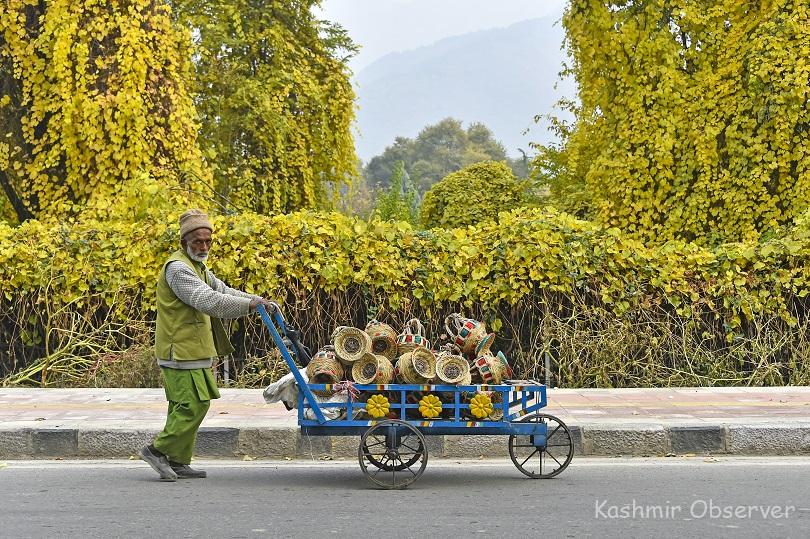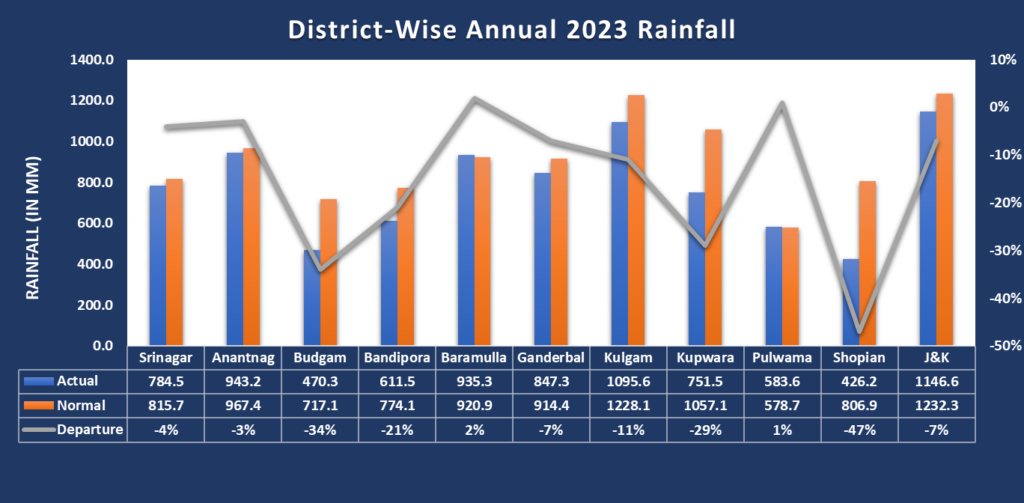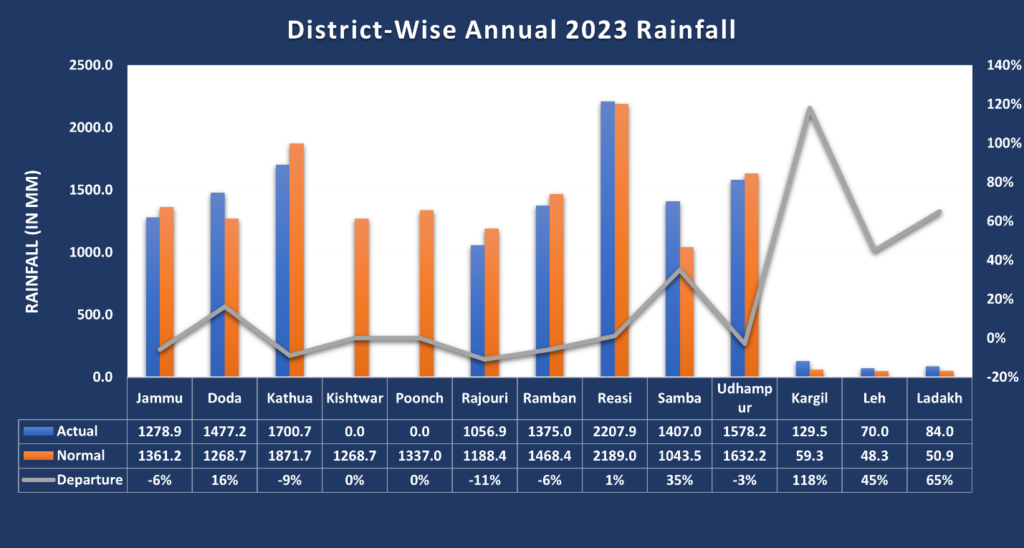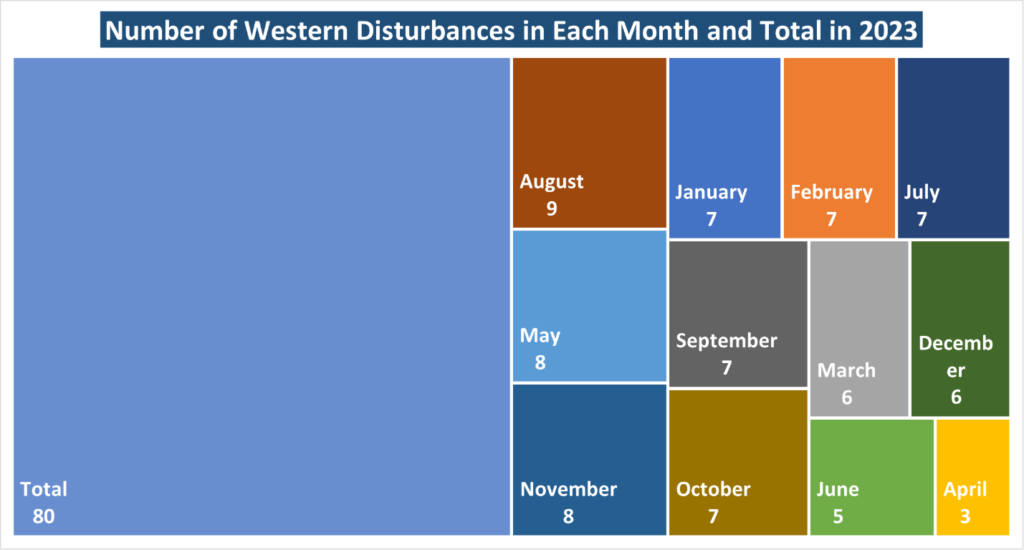
By Faizan Arif
So, 2024 has kicked off with this never-ending dry spell since December. Water springs are practically on vacation. No snow in the hills, and good luck figuring out if it’s Autumn or Winter – temperatures are the only clue.
And 2023? The year was a meteorological rollercoaster stuck on repeat! From record-breaking rainfall in Jammu and Kashmir to searing heatwaves rewriting temperature norms, the climate script was far from ordinary. The Union Territory experienced an unsteady rainfall pattern, with some areas grappling with intense downpours while others faced the challenges of drought.
In essence, the weather narrative of 2023 in Jammu and Kashmir is a tale of contrasts and extremes. It underscores the vulnerability of region to the impacts of climate change and the importance of adaptive measures.
This article explores the weather dynamics of 2023, offering a monthly breakdown of rainfall and shedding light on the impact of Western Disturbances. It identifies key temperature and rainfall records, presenting a concise overview of the extraordinary climatic events that unfolded in the region.
Rainfall Metrics: Jammu and Kashmir experiences 7% deficit rainfall in 2023
Beginning with a 42% excess in January and concluding with a substantial 79% shortage in December, Jammu and Kashmir faced an overall 7% deficit in rainfall throughout 2023. The region received only 1146.6 mm of rainfall, contrasting with the usual 1232.3 mm. Negative departures from normal were observed in 13 districts, while 5 districts experienced positive departures. The total rainfall data for Kishtwar and Poonch districts was unavailable due to the non-functionality of Automatic Weather Stations since June and September, respectively.
Shopian displayed the most substantial negative departure at -47%, followed by Budgam at -34% and Kupwara at -29%. Bandipora experienced a negative departure of -21%, while Rajouri and Kulgam shared an -11% departure each. Kathua recorded a -9% departure, Ganderbal -7%, Srinagar -4%, and both Jammu and Ramban recorded it at -6%. Anantnag and Udhampur had negative departures of -3% each. On the positive side, Samba recorded a significant +35% departure, followed by Doda at +16%, Baramulla at +2%, and Reasi and Pulwama, each registering a +1% departure in rainfall.
In terms of monthly performance, October exhibited the highest surplus rainfall at +141%, followed by January at +42%, and July at +35%. Conversely, December recorded the most substantial deficit at -79%, with February following closely at -69%. The data shows that March had a negative departure of -48%, while April showed a positive departure of +14%. May, June, and November experienced departures of +24%, +8%, and +10%, respectively, while August and September witnessed deficits of -29% and -18%, based on departures from normal rainfall levels.
Ladakh Union Territory experienced a 65% surplus in rainfall. The recorded rainfall of 84.0 mm surpassed the usual 50.9 mm. Kargil saw a substantial 118% surplus, while Leh observed a 45% surplus in comparison to their respective normal rainfall levels.
(The data is based on analysis of data obtained from India Meteorological Department.)


2. 80 Western Disturbances affect J&K and Ladakh:
In 2023, Jammu and Kashmir was impacted by a total of 80 Western Disturbances. A peak of 9 occurrences was recorded in August, which is unusual, while the lowest count, at 3, took place in April. The distribution across other months was as follows: 7 each in January and February, 6 in March, 8 in May, 5 in June, 7 each in July, September, and October, 8 in November, and December witnessed 6 Western Disturbances.
(The data is based on the analysis of wind patterns and forecasts provided by Global Forecast System (GFS) weather model, produced by the National Centers for Environmental Prediction (NCEP).

3. Extreme Temperature Records:
The winter season etched new records into its history. On January 5, Srinagar logged a minimum temperature of minus 6.5 degrees Celsius, marking the second-lowest temperature recorded in January in the past five years. Moving to February 12, Gulmarg reported a minimum temperature of minus 13.5 degrees Celsius, standing as the second-lowest February temperature in a decade for Gulmarg. On February 11, Jammu recorded its lowest February temperature in the last 11 years, at 3.6 degrees Celsius.
As summer approached, temperature records continued to tumble. On June 23, Srinagar experienced its hottest June day in 18 years, with temperatures peaking at 35.0 degrees Celsius. On the same day, Qazigund recorded its second-highest maximum temperature in June in 33 years, hitting 34.2 degrees Celsius. Kokernag and Pahalgam also saw their hottest June day in 18 years and 15 years, respectively. On June 24, Srinagar recorded a minimum temperature of 22.4 degrees Celsius, the highest minimum temperature in June in 15 years, tying with the record set the previous year. Srinagar witnessed its lowest maximum temperature in July since 2010 on July 8, registering 19.2 degrees Celsius.
Autumn added a few records as well. On September 10, Gulmarg reported a maximum of 24.0 degrees Celsius, breaking all previous records since 2009 set in the month. On September 12, Srinagar marked its second-highest-ever temperature in September since 1891 when the weather observatory was established, recording a temperature of 34.2 degrees Celsius. On the same day, Qazigund and Kokernag recorded their highest-ever maximum temperatures in September, reaching 33.2 and 32.0 degrees Celsius, respectively.
4. Extreme Rainfall Records:
On May 8, Qazigund and Kokernag recorded their highest 24-hour rainfall in May since 2010, measuring 49.8 mm and 62.2 mm, respectively. Additionally, Banihal experienced its highest 24-hour rainfall since 2013 at 40.2 mm.
Kathua witnessed a whopping 296.0 mm of rainfall within 24 hours in Kathua on July 9. Simultaneously, Bhaderwah marked its highest 24-hour rainfall in July since 2005, reaching 125.1 mm.
Reasi district was hit by a cloudburst on July 19, a cloudburst hit Reasi, impacting the Katra station. Katra station, located in Reasi, recorded 315.4 mm of rainfall in just 24 hours, breaking all previous records set in July. In the 30-hour period, the total rainfall reached 413.6 mm.
Srinagar experienced its wettest July in at least the last 131 years, recording 187.2 mm of rainfall. Qazigund witnessed its wettest July since 1996 with a total rainfall of 197.7 mm. Pahalgam reported its second-highest all-time rainfall at 225.5 mm, while Gulmarg recorded its highest July rainfall in the last 13 years, at 144.8 mm.
The record-breaking rainfall and searing heatwaves witnessed in 2023 highlight the growing threat posed by extreme weather events. These temperature anomalies can have severe implications for human health, agriculture, and natural ecosystems. The juxtaposition of intense rainfall and extreme heat emphasizes the complexity of climate interactions and the cascading effects they can have on the environment.
As we are into the new year, the lessons learned from the meteorological events of the last year are invaluable. The imperative to adapt to a changing climate becomes apparent, and the importance of proactive measures to mitigate the impacts of extreme weather events becomes necessary. This includes implementing resilient infrastructure, developing sustainable water management strategies, and enhancing community preparedness for both flooding and drought conditions. Policymakers, communities, and stakeholders must collaborate to build resilience and enhance preparedness for the inevitable challenges posed by a changing climate.
Views expressed in the article are the author’s own and do not necessarily represent the editorial stance of Kashmir Observer
Author is an independent weather forecaster, also known by ‘Kashmir Weather’ name across social media platforms
Follow this link to join our WhatsApp group: Join Now
Be Part of Quality Journalism |
Quality journalism takes a lot of time, money and hard work to produce and despite all the hardships we still do it. Our reporters and editors are working overtime in Kashmir and beyond to cover what you care about, break big stories, and expose injustices that can change lives. Today more people are reading Kashmir Observer than ever, but only a handful are paying while advertising revenues are falling fast. |
| ACT NOW |
| MONTHLY | Rs 100 | |
| YEARLY | Rs 1000 | |
| LIFETIME | Rs 10000 | |











